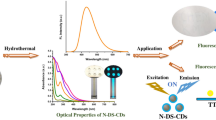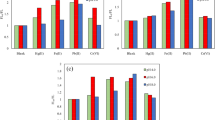Abstract
This article has introduced and examined a novel and green approach for the very first time, which had been developed for the synthesis of carbon dots (CDs) and performed through the utilization of Elaeagnus angustifolia (E. A) as a natural carbon source. This straightforward procedure has been based upon a hydrothermal treatment with a quantum yield of 16.8% that had been designed to synthesize water-soluble CDs in one step and result in a satisfying fluorescence. Additionally, we have attempted to assess the sensing system that had been exerted through the usage of CDs for the detection of food colorant tartrazine, since they can function as a fluorescent sensor due to the interplay that occurs among tartrazine and CDs leading to the quenching of their fluorescence. The detection limit has been measured to be equaled to 0.086 μM (86 nM) and the linear range has been observed to be 0.47–234 μM. The proposed highly sensitive and simple method has exhibited an excellent selectivity and proved to be effectively applicable for distinguishing the tartrazine of real samples.










Similar content being viewed by others
Data Availability
Not applicable.
References
Xu L, Baldocchi DD, Tang J (2004) How soil moisture, rain pulses, and growth alter the response of ecosystem respiration to temperature. Glob Biogeochem Cycles 18(4)
Lim S, Wyker B, Bartley K, Eisenhower D (2015) Lim et al. respond to “measurement error and physical activity”. Am J Epidemiol 181(9):659–660
Liu X, Xu W, Pan Y, Du E (2015) Liu et al. suspect that Zhu et al. (2015) may have underestimated dissolved organic nitrogen (N) but overestimated total particulate N in wet deposition in China. Sci Total Environ 520:300–301. https://doi.org/10.1016/j.scitotenv.2015.03.004
Schmitt A, Malchow B, Hasan A, Fallkai P (2014) The impact of environmental factors in severe psychiatric disorders. Front Neurosci 8:19
Zhang Q, Liang J, Zhao L, Wang Y, Zheng Y, Wu Y, Jiang L (2020) Synthesis of novel fluorescent carbon quantum dots from Rosa roxburghii for rapid and highly selective detection of o-nitrophenol and cellular imaging. Frontiers in chemistry 8:665
Rahnama A, Ramezani Z (2018) Carbon quantum dots in environmental remediation. International Journal of Environmental Sciences & Natural Resources 10(4):158–161
Edison AS, Hall RD, Junot C, Karp PD, Kurland IJ, Mistrik R, Reed LK, Saito K, Salek RM, Steinbeck C (2016) The time is right to focus on model organism metabolomes. Metabolites 6(1):8
Sahu SK, Thangaraj M (2012) Kathiresan K (2012) DNA extraction protocol for plants with high levels of secondary metabolites and polysaccharides without using liquid nitrogen and phenol. International Scholarly Research Notices
Niu K, Messier J, He J-S, Lechowicz MJ (2015) The effects of grazing on foliar trait diversity and niche differentiation in Tibetan alpine meadows. Ecosphere 6(9):1–15
Zhou X, Wildschut T, Sedikides C, Chen X, Vingerhoets AJ (2012) Heartwarming memories: nostalgia maintains physiological comfort: correction to Zhou et al
Xiang X, Piers TM, Wefers B, Zhu K, Mallach A, Brunner B, Kleinberger G, Song W, Colonna M, Herms J, Wurst W, Pocock JM, Haass C (2018) The Trem2 R47H Alzheimer’s risk variant impairs splicing and reduces Trem2 mRNA and protein in mice but not in humans. Mol Neurodegener 13(1):49. https://doi.org/10.1186/s13024-018-0280-6
Liu C, Allan RP, Mayer M, Hyder P, Loeb NG, Roberts CD, Valdivieso M, Edwards JM, Vidale PL (2017) Evaluation of satellite and reanalysis-based global net surface energy flux and uncertainty estimates. Journal of Geophysical Research: Atmospheres 122(12):6250–6272
Surendran P, Lakshmanan A, Priya SS, Balakrishnan K, Rameshkumar P, Kannan K, Geetha P, Hegde TA, Vinitha G (2020) Bioinspired fluorescence carbon quantum dots extracted from natural honey: efficient material for photonic and antibacterial applications. Nano-Structures & Nano-Objects 24:100589. https://doi.org/10.1016/j.nanoso.2020.100589
Qu X, Su L, Li H, Liang M, Shi H (2018) Assessing the relationship between the abundance and properties of microplastics in water and in mussels. Sci Total Environ 621:679–686
Öztürk Hİ, Aydın S, Sözeri D, Demirci T, Sert D, Akın N (2018) Fortification of set-type yoghurts with Elaeagnus angustifolia L. flours: effects on physicochemical, textural, and microstructural characteristics. LWT 90:620–626
Khadivi A (2018) Phenotypic characterization of Elaeagnus angustifolia using multivariate analysis. Ind Crop Prod 120:155–161
Ghoreishi SM, Behpour M, Golestaneh M (2012) Simultaneous determination of sunset yellow and tartrazine in soft drinks using gold nanoparticles carbon paste electrode. Food Chem 132(1):637–641
Llamas NE, Garrido M, Di Nezio MS, Band BSF (2009) Second order advantage in the determination of amaranth, sunset yellow FCF and tartrazine by UV–vis and multivariate curve resolution-alternating least squares. Anal Chim Acta 655(1–2):38–42
El Rabey HA, Al-Seeni MN, Al-Sieni AI, Al-Hamed AM, Zamzami MA, Almutairi FM (2019) Honey attenuates the toxic effects of the low dose of tartrazine in male rats. J Food Biochem 43(4):e12780
Wang Y, Mu Y, Hu J, Zhuang Q, Ni Y (2019) Rapid, one-pot, protein-mediated green synthesis of water-soluble fluorescent nickel nanoclusters for sensitive and selective detection of tartrazine. Spectrochim Acta A Mol Biomol Spectrosc 214:445–450
Alp H, Başkan D, Yaşar A, Yaylı N, Ocak Ü, Ocak M (2018) Simultaneous determination of sunset yellow FCF, allura red AC, quinoline yellow WS, and tartrazine in food samples by RP-HPLC. Journal of Chemistry 2018:1–6
Hurst W, McKim J, Martin R Jr (1981) Determination of tartrazine in food products by HPLC. J Food Sci 46(2):419–420
Gianotti V, Angioi S, Gosetti F, Marengo E, Gennaro M (2005) Chemometrically assisted development of IP-RP-HPLC and spectrophotometric methods for the identification and determination of synthetic dyes in commercial soft drinks. J Liq Chromatogr Relat Technol 28(6):923–937
de Andrade FI, Guedes MIF, Vieira ÍGP, Mendes FNP, Rodrigues PAS, Maia CSC, Ávila MMM, de Matos RL (2014) Determination of synthetic food dyes in commercial soft drinks by TLC and ion-pair HPLC. Food Chem 157:193–198
Gan T, Sun J, Cao S, Gao F, Zhang Y, Yang Y (2012) One-step electrochemical approach for the preparation of graphene wrapped-phosphotungstic acid hybrid and its application for simultaneous determination of sunset yellow and tartrazine. Electrochim Acta 74:151–157
Song Y, Xu J, Lv J, Zhong H, Ye Y, Xie J (2012) Electrochemical reduction of tartrazine at multi-walled carbon nanotube-modified pyrolytic graphite electrode. Russ J Phys Chem A 86(2):303–310
Thulasi S, Kathiravan A, Asha Jhonsi M (2020) Fluorescent carbon dots derived from vehicle exhaust soot and sensing of Tartrazine in soft drinks. ACS Omega 5(12):7025–7031. https://doi.org/10.1021/acsomega.0c00707
Banerjee T, Singh A, Sharma R, Maitra A (2005) Labeling efficiency and biodistribution of technetium-99m labeled nanoparticles: interference by colloidal tin oxide particles. Int J Pharm 289(1–2):189–195
Yang X, Xu J, Luo N, Tang F, Zhang M, Zhao B (2020) N, Cl co-doped fluorescent carbon dots as nanoprobe for detection of tartrazine in beverages. Food Chem 310:125832
Sobhani R, Rezaei B, Shahshahanipour M, Ensafi AA, Mohammadnezhad G (2019) Simple and green synthesis of carbon dots (CDs) from valerian root and application of modified mesoporous boehmite (AlOOH) with CDs as a fluorescence probe for determination of imipramine. Anal Bioanal Chem 411(14):3115–3124
Yvon HJ (2012) A guide to recording fluorescence quantum yields. Middlesex, UK, HORIBA Jobin Yvon Inc
Shaikh AF, Tamboli MS, Patil RH, Bhan A, Ambekar JD, Kale BB (2019) Bioinspired carbon quantum dots: an antibiofilm agents. J Nanosci Nanotechnol 19(4):2339–2345
Yan F, Bai Z, Zu F, Zhang Y, Sun X, Ma T, Chen L (2019) Yellow-emissive carbon dots with a large stokes shift are viable fluorescent probes for detection and cellular imaging of silver ions and glutathione. Microchim Acta 186(2):1–11
Rao BS, Kumar BR, Reddy VR, Rao TS, Chalapathi G (2011) Preparation and characterization of CdS nanoparticles by chemical co-precipitation technique. Chalcogenide Lett 8(3):177–185
Sabouri Z, Fereydouni N, Akbari A, Hosseini HA, Hashemzadeh A, Amiri MS, Kazemi Oskuee R, Darroudi M (2019) Plant-based synthesis of NiO nanoparticles using salvia macrosiphon Boiss extract and examination of their water treatment. Rare Metals 39:1134–1144. https://doi.org/10.1007/s12598-019-01333-z
Sabouri Z, Akbari A, Hosseini HA, Khatami M, Darroudi M (2020) Egg white-mediated green synthesis of NiO nanoparticles and study of their cytotoxicity and photocatalytic activity. Polyhedron: 114351
Song J, Li J, Guo Z, Liu W, Ma Q, Feng F, Dong C (2017) A novel fluorescent sensor based on sulfur and nitrogen co-doped carbon dots with excellent stability for selective detection of doxycycline in raw milk. RSC Adv 7(21):12827–12834
Sabouri Z, Akbari A, Hosseini HA, Hashemzadeh A, Darroudi M (2019) Bio-based synthesized NiO nanoparticles and evaluation of their cellular toxicity and wastewater treatment effects. J Mol Struct 1191:101–109. https://doi.org/10.1016/j.molstruc.2019.04.075
Otavo-Loaiza RA, Sanabria-González NR, Giraldo-Gómez GI (2019) Tartrazine removal from aqueous solution by HDTMA-Br-modified Colombian bentonite. The Scientific World Journal 2019
Chatzimitakos T, Kasouni A, Sygellou L, Avgeropoulos A, Troganis A, Stalikas C (2017) Two of a kind but different: luminescent carbon quantum dots from Citrus peels for iron and tartrazine sensing and cell imaging. Talanta 175:305–312
Niu X, Liu G, Li L, Fu Z, Xu H, Cui F (2015) Green and economical synthesis of nitrogen-doped carbon dots from vegetables for sensing and imaging applications. RSC Adv 5(115):95223–95229
Xu H, Yang X, Li G, Zhao C, Liao X (2015) Green synthesis of fluorescent carbon dots for selective detection of tartrazine in food samples. J Agric Food Chem 63(30):6707–6714
Wang Y, Wang K-M, Shen G-l, Yu R-Q (1997) A selective optical chemical sensor for o-nitrophenol based on fluorescence quenching of curcumin. Talanta 44(7):1319–1327
Guo L, Zeng X, Lan J, Yun J, Cao D (2017) Absorption competition quenching mechanism of porous covalent organic polymer as luminescent sensor for selective sensing Fe3+. ChemistrySelect 2(3):1041–1047
Wang Y, Zhu Y, Yu S, Jiang C (2017) Fluorescent carbon dots: rational synthesis, tunable optical properties and analytical applications. RSC Adv 7(65):40973–40989
Acknowledgements
The authors gratefully acknowledge the technical support of this work that has been provided by Ferdowsi University of Mashhad and Mashhad University of Medical Sciences based on the Ph. D thesis of Mrs. M. Ghereghlou.
Author information
Authors and Affiliations
Contributions
Mahnaz Ghereghlou: Writing original draft, synthesized and characterized the compounds using XRD, UV-Vis, TRM, FTIR techniques. Abbas Ali Esmaeili: Data acquisition, analysis and interpretation, review and editing, Funding and resources acquisition. Majid Darroudi: Supervision, Project administration, review & editing, Funding and resources acquisition.
Corresponding authors
Ethics declarations
The authors have declared no conflict of interest.
Ethics Approval
For this type of study, the ethical approval was not.
Additional information
Publisher’s Note
Springer Nature remains neutral with regard to jurisdictional claims in published maps and institutional affiliations.
Rights and permissions
About this article
Cite this article
Ghereghlou, M., Esmaeili, A.A. & Darroudi, M. Green Synthesis of Fluorescent Carbon Dots from Elaeagnus angustifolia and its Application as Tartrazine Sensor. J Fluoresc 31, 185–193 (2021). https://doi.org/10.1007/s10895-020-02645-5
Received:
Accepted:
Published:
Issue Date:
DOI: https://doi.org/10.1007/s10895-020-02645-5




